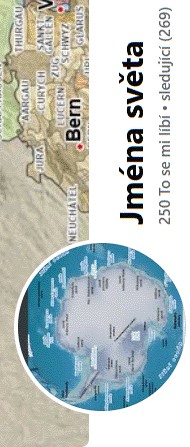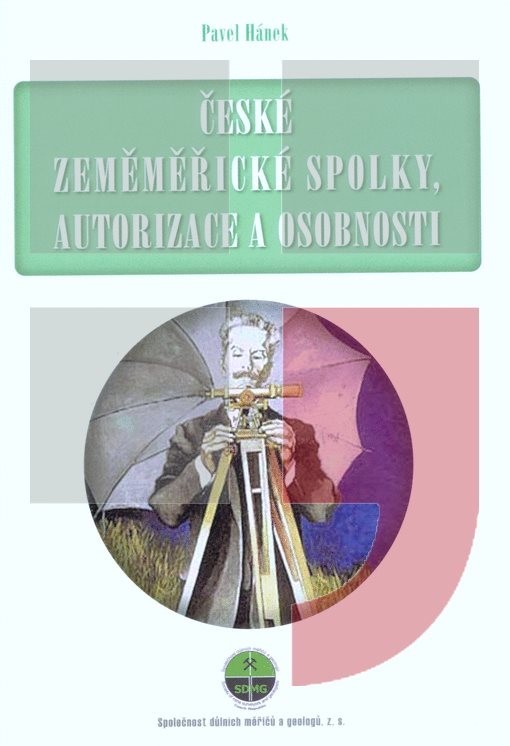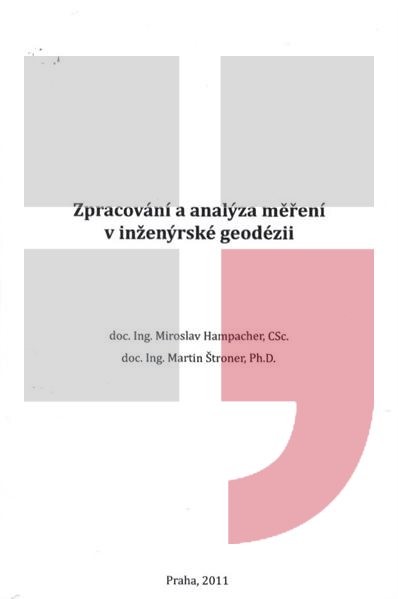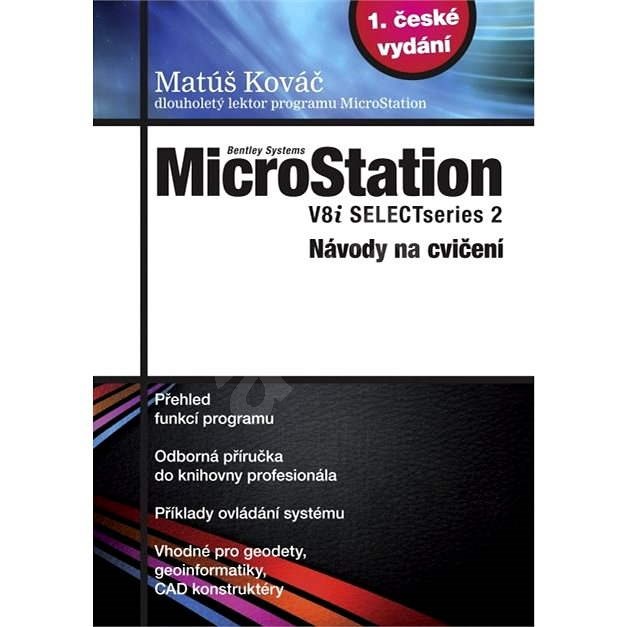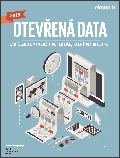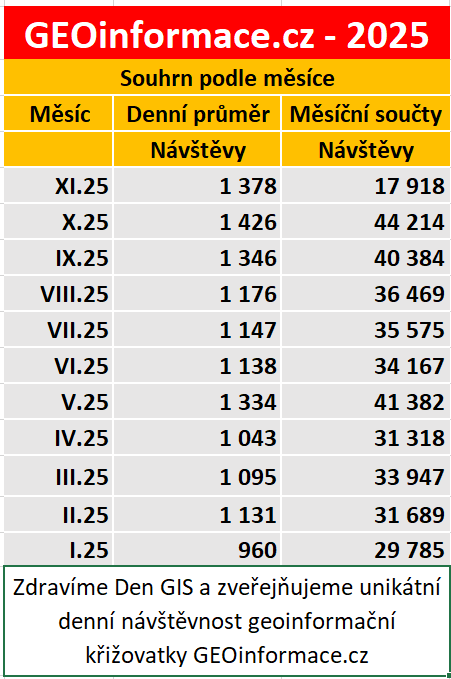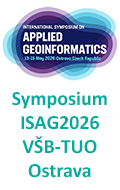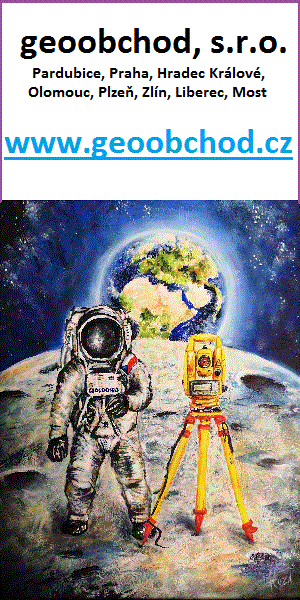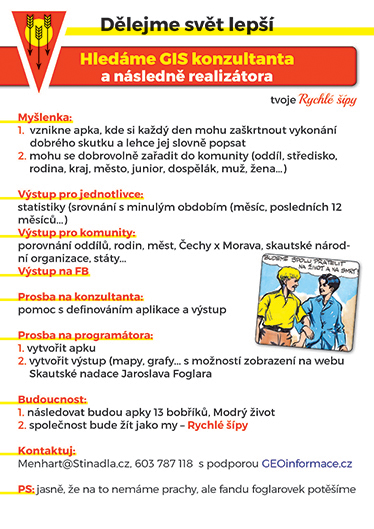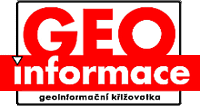zprávy
zdroje zpráv:Představte svoji práci na Konferenci GIS Esri v ČR 2021
21.9.2021 10:55 ARCDATAListopadová konference GIS Esri se blíží a s ní i možnost představit svoji práci na největším setkání geoinformatiků v ČR. Pokud máte zajímavý projekt, který by někomu mohl zjednodušit práci nebo poskytnout inspiraci, určitě nám o sobě dejte vědět.
V letošním roce konference proběhne 3. a 4. listopadu virtuální formou. I když se tedy nebudeme moci setkat osobně, můžete – právě díky virtuálnímu formátu – oslovit mnohem širší publikum než obvykle. Prezentovat se navíc můžete několika různými způsoby:
- Předtočení video přednášky
- Účast v přehlídce map a online aplikací
- Obrázek či mapa v zahajovací prezentaci
Pokud se rozhodnete pro natočenípřednášky, může Vám pomoci tento jednoduchý návod, který je stejně jako vzor abstraktu k nalezení na webových stránkách akce. Termín pro přihlášení příspěvku je 30. září 2021.
Zpracování mračen bodů z DJI L1 pomocí softwaru Terrasolid
21.9.2021 6:43 GeoBusinessFinská firma Terrasolid je producentem stejnojmenného softwaru Terrasolid, používaného pro zpracování mračen bodů a snímků. Na tomto webináři se seznámíte s kroky zpracování mračen bodů z LiDARové kamery L1 od DJI: Import mračna bodů a řešení trajektorie Odstranění nadbytečných dat Vyhlazování mračna bodů Klasifikace „zásahů“ do země Klasifikace „zásahů“ stromů, vegetace a střech budov Přizpůsobení nadmořské výšky dat kontrolním bodům […]
The post Zpracování mračen bodů z DJI L1 pomocí softwaru Terrasolid appeared first on GeoBusiness.
Bentley Systems Announces Finalists for the 2021 Going Digital Awards in Infrastructure
21.9.2021 3:27 GISCafe.com Webcasts-Webinars Finalists Also Announced for the Student Future Infrastructure Star ChallengeEXTON, Pa. — (BUSINESS WIRE) — September 20, 2021 …
Bentley Systems Announces Finalists for the 2021 Going Digital Awards in Infrastructure
20.9.2021 22:04 Bentley SystemsPress Announcements
Crunchy Data Delivers Trusted PostgreSQL Containers In Collaboration With The U.S. Department Of Defense
20.9.2021 21:40 GISCafe.com Webcasts-Webinars Crunchy PostgreSQL containers for Kubernetes have been approved for inclusion in Iron Bank, the DoD centralized repository for top development tools …AGM Selects Velodyne Lidar’s Alpha Prime Sensor for New Mobile Scanning System
20.9.2021 15:26 GISCafe.com Webcasts-Webinars AGM Provides Accurate and Powerful Mobile Mapping for Complex Applications Including Infrastructure, Smart City, MoreSAN JOSE, Calif. — …
On the Roof of Ecuador, XAG Spearheads Drones for Sustainable Andean Farming
20.9.2021 15:26 GISCafe.com Webcasts-Webinars QUITO, Ecuador, Sept. 20, 2021 — (PRNewswire) — Flying into the Andes mountains of Ecuador, XAG Agricultural Drones were recently …Pondělí, 20. 9. omezení výpůjční doby [Knihovna geografie, byTopic]
20.9.2021 13:30 Katedra aplikované geoinformatiky a kartografie Přf UK3D ve vzduchu i na zemi – pozvánka
20.9.2021 12:36 GeoBusinessSpolečnost 3GON Positioning všechny srdečně zve na akci, nazvanou 3D ve vzduchu i na zemi. Akce se uskuteční dvakrát, v Praze a Brně. října 2021 – Praha – Hotel Chvalská Tvrz, Na Chvalské tvrzi 858/11 října 2021 – Brno – Hotel Avanti, Střední 61 Program 09:30 – Registrace 10:00 – Představení techniky od DJI Enterprise 10:20 – DJI […]
The post 3D ve vzduchu i na zemi – pozvánka appeared first on GeoBusiness.
Gaudeamus Hejčín 2021
20.9.2021 11:55 Katedra geoinformatiky UP OlomoucBudoucí maturanti se začali již v září seznamovat se studijním oborem Geo informatika. Honza Roller prezentoval studium na Hejčínském gaudeámu v pátek 17. 9. 2021. Chcete taky propagovat geoinformatiku na své střední škole? Kontaktujte jakub.konicek@upol.cz
The post Gaudeamus Hejčín 2021 appeared first on Katedra geoinformatiky.
5 ways the EU Space Programme makes urban mobility more sustainable
20.9.2021 11:53 European GNSS Agency
The 20th EUROPEAN MOBILITY WEEK is on! This year’s motto is ‘Safe and Healthy with Sustainable Mobility’ paying tribute to the hardships felt by Europe – and the world – throughout the COVID-19 pandemic. Space is a significant booster in the development of new, intelligent mobility solutions as well as the monitoring of important urban infrastructures.
The European Mobility Week is the European Commission’s flagship awareness-raising campaign on sustainable urban mobility, promoting new ways of living in favour of active mobility, public transport, and other clean, intelligent transport solutions. The benefits of space services and data for sustainability and smart mobility are currently under the spotlight as the Union is investing more on its EU Space Programme for the definition of its green and digital policies. Here are 5 ways the EU Space Programme is positively impacting sustainable mobility:
1. Streamlining urban traffic
Transport is one of the main sources of air pollution, which is known to have direct effect on mortality as well as respiratory and cardiovascular diseases. The use of satellite navigation systems such as Galileo in vehicles can reduce journey times by more than 10%, and thus contribute to reducing emissions of harmful and polluting substances. Copernicus services can support emissions monitoring by validating the measurements from existing sensors and providing data from areas not covered otherwise.
2. Contributing to Intelligent Transport Systems (ITS)
ITS systems rely on positioning data, which has now become much more precise thanks to Galileo services. With the help of the EU’s GNSS, advanced implementation of Intelligent Transport System (ITS) is now becoming a reality for transport and mobility companies. The city of Madrid was among the first to integrate Galileo’s enhanced positioning services into its Transport System to improve public transport services in the Spanish capital. EU Space technology is becoming fundamental for the development of smart mobility solutions targeting the EU Green Deal.
3. Mobility infrastructure monitoring
Copernicus offers a broad range of products and services based on satellite optical data. Lidar images, can for instance, help urban planning authorities to identify changes in the terrain such as land subsidence or vegetation that could encroach rail tracks or power grids supplying the city with electricity. The combination of imagery from Copernicus with the very accurate positioning provided by Galileo allows for the monitoring of critical infrastructures tunnels, motorways and bridges.
4. Easing the flow of goods between EU cities during COVID-19
Developed by EUSPA in collaboration with the European Commission, the Galileo Green Lane app is a key tool in the EU’s COVID-19 pandemic response. By easing traffic flow through the EU’s borders, the app is helping to support a fundamental EU principle - the free movement of goods and freight in the internal market.
5. Faster emergency response on the road
As of April 2018, all new car models in the European Union are equipped with eCall technology. In the event of a serious accident, eCall automatically dials 112 - Europe's single emergency number - to provide faster assistance. Leveraging Galileo, the system sends the accurate position of the crashed vehicle and the direction of travel to the emergency services, enabling the emergency responders to get to the accident site faster. By speeding up emergency response times by 40% in urban areas and 50% in the countryside, it is estimated that eCall could help prevent 2,500 road deaths and save EUR 26 billion every year.
Towns and cities worldwide are invited to participate in the EUROPEANMOBILITYWEEK, which takes place 16-22 September each year, check out the interactive map to see if your city is taking part.
More info and registration here
Media note: This feature can be republished without charge provided the European Union Agency for the Space Programme (EUSPA) is acknowledged as the source at the top or the bottom of the story. You must request permission before you use any of the photographs on the site. If you republish, we would be grateful if you could link back to the EUSPA website (http://www.euspa.europa.eu).
Müllerova mapa Čech v 10 přednáškách odborníků
20.9.2021 11:24 GeoBusinessKatedra geomatiky Stavební fakulty ČVUT v Praze nahrála deset přednášek konference k 300. výročí Müllerovy mapy Čech. Eva Semotanová – Jan Kryštof Müller a evropská kartografie Jiří Martínek – Život Jana Kryštofa Müllera Jiří Hrbek – Společnost v době Jana Kryštofa Müllera Tomáš Janata – Müllerova mapa Království českého z pohledu kartografa Močičková/Vokurka – Nově objevený rukopisný rejstřík k Müllerově mapě Jiří […]
The post Müllerova mapa Čech v 10 přednáškách odborníků appeared first on GeoBusiness.
Vectorworks uvádí na trh verzi 2022 svých softwarů pro BIM a CAD
20.9.2021 10:49 BIM NewsSpolečnost Vectorworks vydává novou produktovou řadu Vectorworks 2022 s důrazem na technologické postupy nové generace, pracovní postupy 3D a BIM, součinnost, krajinotvorbu a pracovní postupy GIS a zábavního designu. Vectorworks svou produktovou řadu přejmenovala, aby přesněji reflektovala navrhování s pomocí BIM. Vectorworks Design Suite, dříve známá pod názvem Vectorworks Designer, však i nabízí všechny aktuální […]
The post Vectorworks uvádí na trh verzi 2022 svých softwarů pro BIM a CAD appeared first on BIM News.
Georadar Stream T změří anomálie v tunelech rychlostí až 60 km/hod
20.9.2021 10:40 ZeměměřičGeoradar Stream T, který představila firma IDS, měří anomálie v tunelech, jako je tloušťka ostění, vyztužené konstrukce, dutiny a vlhké oblasti. Modulární konstrukce systému Stream T umožňuje této inovativní georadarové soustavě překonávat překážky a pětinásobně zvýšit produktivitu ve srovnání s tradičními systémy a sbírat data rychlostí až 60 km/hod. Ovládání systému Stream T z interiéru vozidla zvyšuje bezpečnost techniků na místě […]
The post Georadar Stream T změří anomálie v tunelech rychlostí až 60 km/hod appeared first on Zeměměřič.
Robotické autonomní skenování s novým Leica BLK ARC
20.9.2021 10:29 ZeměměřičLeica Geosystems představila BLK ARC, svůj autonomní laserový skenovací modul pro roboty. Je určen k integraci s robotickými nosiči, aby umožnil autonomní mobilní laserové skenování s minimálním nebo žádným zásahem člověka. Uživatelé pouze nastaví trasu skenování. Pvním robotickým nosičem je robot Spot od Boston Dynamics. BLK ARC ve spojení se Spotem vytváří rychlý, jednoduchý, bezpečný a autonomní pracovní postup […]
The post Robotické autonomní skenování s novým Leica BLK ARC appeared first on Zeměměřič.
Odborný rada - metodik legislativy v oddělení metodiky, kontroly a personalistiky kanceláře ředitele
20.9.2021 10:07 ČÚZK /Urady/Katastralni-urady/Katastralni-urady/Katastralni-urad-pro-Kralovehradecky-kraj/Uredni-deska/Oznameni-a-jina-uredni-sdeleni/Volna-mista/Odborny-rada-metodik-legislativy-v-oddeleni-metoOdborný rada - metodik legislativy v oddělení metodiky, kontroly a personalistiky kanceláře ředitele
20.9.2021 10:07 ČÚZK - volná místa Katastrální úřad pro Královéhradecký kraj vypisuje výběrové řízení na místo Odborný rada - metodik legislativy v oddělení metodiky, kontroly a personalistiky kanceláře řediteleOdborný rada - metodik legislativy v oddělení metodiky, kontroly a personalistiky kanceláře ředitele
20.9.2021 10:07 ČÚZK - předpisy a opatření Katastrální úřad pro Královéhradecký krajvypisuje výběrové řízení na místo
Odborný rada - metodik legislativy v oddělení metodiky, kontroly a personalistiky kanceláře ředitele Katastrálního úřadu pro Královéhradecký kraj
Byl publikován Drone Industry Barometer 2021, kterého byla Aliance partnerem
20.9.2021 10:00 UAVATento týden byl publikován největší světový průzkum Drone Industry Barometer 2021 od Drone Industry Insights, kterého byla Aliance opět partnerem a který je k dispozici ke stažení zdarma. Tohoto rozsáhlého průzkumu se zúčastnilo téměř 700 firem z 64 států světa a přináší aktuální výsledky z drone industry. Ke stažení zdarma zde: https://droneii.com/project/drone-industry-barometer
The post Byl publikován Drone Industry Barometer 2021, kterého byla Aliance partnerem appeared first on UAV Aliance pro bezpilotní letecký průmysl.
Joining forces for Aeolus
20.9.2021 9:00 ESA Observing the Earth
For a team of scientists and technicians from Europe and the US, the fact of ‘going back to the office’ this September has meant heading off to the Cabo Verde islands in the Atlantic – not to extend their summer holidays, but for a complex international experiment campaign that will scrutinise the data being delivered by one of today’s most innovative Earth observation satellites: ESA’s Aeolus wind mission.
Kartografická výročí 2020/2021 – 300 let Müllerovy mapy Čech
20.9.2021 8:00 GISportal.cz
Seminář pod názvem Kartografická výročí 2020/2021 – 300 let Müllerovy mapy Čech formou ozvučených prezentací, které je možné shlédnout od 15. září 2021. Hlavními pořadateli jsou Česká kartografická společnost ve spolupráci s Historickým ústavem AV ČR, Katedrou geomatiky ČVUT Fakulty stavební a dalšími institucemi (Filosofická fakulta UJEP a Česká geografická společnost). Jan Kryštof Müller (Johann Christoph […]
The post Kartografická výročí 2020/2021 – 300 let Müllerovy mapy Čech appeared first on GISportal.cz.
Kartografická výročí 2020/2021 – 300 let Müllerovy mapy Čech
20.9.2021 8:00 GISportal.cz
Seminář pod názvem Kartografická výročí 2020/2021 – 300 let Müllerovy mapy Čech formou ozvučených prezentací, které je možné shlédnout od 15. září 2021. Hlavními pořadateli jsou Česká kartografická společnost ve spolupráci s Historickým ústavem AV ČR, Katedrou geomatiky ČVUT Fakulty stavební a dalšími institucemi (Filosofická fakulta UJEP a Česká geografická společnost). Jan Kryštof Müller (Johann Christoph […]
The post Kartografická výročí 2020/2021 – 300 let Müllerovy mapy Čech appeared first on GISportal.cz.
"Tecta America Zero Company Uses Nearmap to Add Value to Roofing Projects" by Susan Smith
18.9.2021 10:52 GISCafe.com Webcasts-WebinarsWoolpert Selected by USGS for Geospatial Products and Services Contract 4
18.9.2021 0:45 GISCafe.com Webcasts-Webinars The shared capacity contract will support federal, state and municipal government needs across the U.S.DAYTON, Ohio, Sept. 17, 2021 — …
Announcing HxGN Live GeoSummit, the flagship digital event of Hexagon's Geosystems division. Towards Autonomous Solutions and Digital Realities — Innovating for the Future.
17.9.2021 18:49 GISCafe.com Webcasts-Webinars (Heerbrugg, Switzerland, 16 September 2021) Hexagon, a global leader in digital reality solutions, is hosting a three-day virtual event, HxGN Live …Hexagon to showcase groundbreaking autonomous solutions and smart digital realities at INTERGEO 2021 Live+Digital
17.9.2021 18:43 GISCafe.com Webcasts-Webinars (Heerbrugg, Switzerland, 16 September 2021) Hexagon, a global leader in digital reality solutions, announces sponsoring and exhibiting at INTERGEO …Nová verze CAD Symbols pro Váš CAD 30 miliónů symbolů
17.9.2021 17:40 ŠPINAR - softwareVážení zákazníci,
dovolujeme si Vám nabídnout program CAD Symbols v 15 s ohromnou databází přes 30 milionů CAD symbolů ve 2D a 3D, které jednoduše vyhledáte a vložíte do svého CAD programu
The post Nová verze CAD Symbols pro Váš CAD 30 miliónů symbolů appeared first on ŠPINAR – software.
Nová verze CAD Symbols – 30 miliónů symbolů
17.9.2021 17:40 ŠPINAR - softwareVážení zákazníci,
dovolujeme si Vám nabídnout program CAD Symbols v 15 s ohromnou databází přes 30 milionů CAD symbolů ve 2D a 3D, které jednoduše vyhledáte a vložíte do svého CAD programu
The post Nová verze CAD Symbols – 30 miliónů symbolů appeared first on ŠPINAR – software.
Nová verze CAD Symbols – 30 miliónů symbolů
17.9.2021 17:40 ŠPINAR - softwareVážení zákazníci,
dovolujeme si Vám nabídnout program CAD Symbols v 15 s ohromnou databází přes 30 milionů CAD symbolů ve 2D a 3D, které jednoduše vyhledáte a vložíte do svého CAD programu
The post Nová verze CAD Symbols – 30 miliónů symbolů appeared first on ŠPINAR – software.
USSOCOM to Receive Robotican Indoor Unmanned Reconnaissance Drone Systems
17.9.2021 17:36 GISCafe.com Webcasts-Webinars OMER, Israel, Sept. 17, 2021 — (PRNewswire) — Robotican has successfully delivered its first indoor UAS to the USSOCOM for operational …DISCOVER MORE INSPIRATIONS | GEOSPATIAL WORLD FORUM 2021
17.9.2021 11:59 Satlab GeosolutionsDISCOVER MORE INSPIRATIONS | GEOSPATIAL WORLD FORUM 2021 Event: Geospatial World Forum 2021 | SatLab New Product Launch Date: 20 – 22 October 2021 Geospatial World Forum 2021 is back! From 20th-22nd, October, the mega geospatial business and technical event is to re-connect the supply and demand of geospatial abilities in Amsterdam, the Netherlands. Under the theme […]
The post DISCOVER MORE INSPIRATIONS | GEOSPATIAL WORLD FORUM 2021 appeared first on SatLab – Global Satellite Positioning Solutions.
Nová verzia Trimble Access 2020.20
17.9.2021 10:19 Geotronics.sk Tento týždeň vyšla nová verzia softvéru Trimble Access pre kontrolné jednotky Trimble TSC7 s OS Windows 10, TDC600 a TCU5 s OS Android. Podrobný popis nových funkcií a opráv chýb starého softvéru nájdete TU: Zmena veľkosti mapy a formulára Teraz môžete pomocou jednoduchého ovládacieho prvku jazdca zmeniť veľkosť ľubovoľného formulára, ktorý sa zobrazí [...]Nová verzia Trimble Access 2020.20
17.9.2021 10:19 Geotronics.sk Tento týždeň vyšla nová verzia softvéru Trimble Access pre kontrolné jednotky Trimble TSC7 s OS Windows 10, TDC600 a TCU5 s OS Android. Podrobný popis nových funkcií a opráv chýb starého softvéru nájdete TU: Zmena veľkosti mapy a formulára Teraz môžete pomocou jednoduchého ovládacieho prvku jazdca zmeniť veľkosť ľubovoľného formulára, ktorý sa zobrazí [...]Leica BLK2FLY je nový autonomní létající laserový skener
17.9.2021 10:00 ZeměměřičFirma Leica Geosystems představila BLK2FLY, světově první plně integrovaný autonomní bezpilotní prostředek s LiDARem. Leica BLK2FLY je autonomní létající laserový skener s pokročilým vyhýbáním se překážkám pro snadné snímání reality z oblohy. Snímá exteriéry budov, stavby a prostředí a vytváří 3D mračna bodů za letu. BLK2FLY je navržen tak, aby se snadno používal: několika jednoduchými klepnutími na tabletu mohou uživatelé […]
The post Leica BLK2FLY je nový autonomní létající laserový skener appeared first on Zeměměřič.
Earth from Space: Maharloo Lake
17.9.2021 10:00 ESA Observing the Earth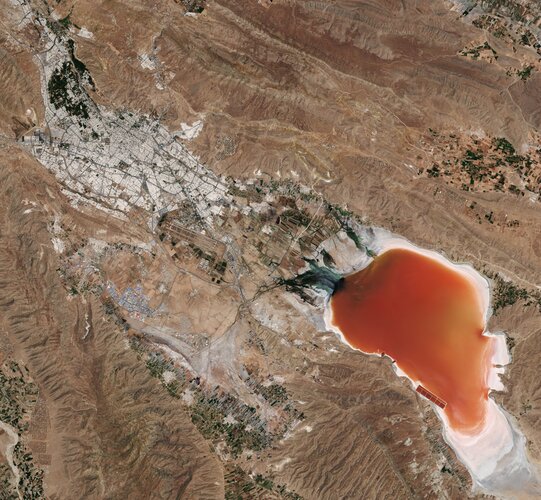
Maharloo Lake, a seasonal salt lake in Iran, is featured in this image captured by the Copernicus Sentinel-2 mission.
Kartograf/ka
17.9.2021 9:01 ČÚZK - volná místa Zeměměřický úřad vypisuje výběrové řízení na místo Kartograf/kaKartograf/ka
17.9.2021 9:01 ČÚZK /Urady/Zememericky-urad/Uredni-deska/Oznameni-a-jina-uredni-sdeleni/Volna-mista/Kartograf-ka-(1)Kartograf/ka
17.9.2021 9:01 Zeměměřický úřad Zeměměřický úřadvypisuje výběrové řízení na místo
Kartograf/ka
Kartograf/ka
17.9.2021 9:01 ČÚZK - předpisy a opatření Zeměměřický úřadvypisuje výběrové řízení na místo
Kartograf/ka
New Mapping Tool for Forest Carbon Hotspots and Biodiversity
17.9.2021 9:00 GISCafe.com Webcasts-Webinars Scientists Identify Forest Carbon “Hotspots” across US with Greatest Potential to Fight Climate Change and Protect SpeciesNew study and …
Bluesky and University of Leicester Use AI to Reduce Data Intensity for Smart City Applications
17.9.2021 9:00 GISCafe.com Webcasts-Webinars Leicestershire, UK, 13 September 2021 - Aerial mapping company Bluesky International and the University of Leicester are using Artificial …KVS Technologies signs US$60 million strategic agreement with US-based Spright to deliver linear infrastructure drone inspection services in North America
16.9.2021 16:42 GISCafe.com Webcasts-Webinars DENVER, Sept. 16, 2021 — (PRNewswire) — KVS Technologies, leading provider of end-to-end drone inspection services for utility …Planet Reports Second Quarter Financial Results and Reaffirms Full Year Outlook
16.9.2021 16:42 GISCafe.com Webcasts-Webinars Delivers Record Second Quarter Revenue of $30.4 Million, Up 19% YoYReiterates $130 million Revenue Outlook for Fiscal Year 2022
SAN FRANCISCO …
RouteSmart and HERE improve delivery optimization tools for postal and parcel industries
16.9.2021 16:42 GISCafe.com Webcasts-Webinars Since 2003, RouteSmart has combined HERE quality street and mapping data with the RouteSmart highly precise routing solutions to power routing, …Luokung Announces eMapgo Signs Cooperation Agreement with Microsoft for Launch of Autonomous Driving Services
16.9.2021 16:42 GISCafe.com Webcasts-Webinars BEIJING, Sept. 16, 2021 — (PRNewswire) — Luokung Technology Corp. (NASDAQ: LKCO) ("Luokung" or the "Company"), a leading …20210916_Odborný rada v oddělení aktualizace KN
16.9.2021 15:34 ČÚZK /Urady/Katastralni-urady/Katastralni-urady/Katastralni-urad-pro-Stredocesky-kraj/Katastralni-pracoviste/KP-Benesov/O-uradu/Aktuality/20210113_odborny-rada,-reditel-Katastralniho-p-(4)20210916_Odborný rada v oddělení aktualizace KN
16.9.2021 15:34 ČÚZK - předpisy a opatření Katastrální úřad pro Středočeský kraj - Katastrální pracoviště Benešov Vyhlášení výběrového řízení: Odborný rada v oddělení aktualizace KN V části "Úřední deska", v sekci "Oznámení a jiná úřední sdělení" bylo vystaveno "Oznámení o vyhlášení výběrového řízení na obsazení systemizovaného místa Odborný rada v oddělení aktualizace KN"Odborný rada v oddělení aktualizace KN
16.9.2021 15:30 ČÚZK - předpisy a opatření Katastrální úřad pro Středočeský kraj - Katastrální pracoviště Benešovvypisuje výběrové řízení na místo Odborný rada v oddělení aktualizace KN
Odborný rada v oddělení aktualizace KN
Odborný rada v oddělení aktualizace KN
16.9.2021 15:30 ČÚZK - volná místa Katastrální úřad pro Středočeský kraj - Katastrální pracoviště Benešov vypisuje výběrové řízení na místo Odborný rada v oddělení aktualizace KNOdborný rada v oddělení aktualizace KN
16.9.2021 15:30 ČÚZK /Urady/Katastralni-urady/Katastralni-urady/Katastralni-urad-pro-Stredocesky-kraj/Volna-mista/Odborny-rada-v-oddeleni-aktualizace-KNodborný/vrchní referent – mzdová/ý účetní v kanceláři ředitele Katastrálního úřadu pro Jihočeský kra
16.9.2021 14:57 ČÚZK /Urady/Katastralni-urady/Katastralni-urady/Katastralni-urad-pro-Jihocesky-kraj/Uredni-deska/Oznameni-a-jina-uredni-sdeleni/Volna-mista/DMS/odborny-vrchni-referent-–-mzdova-y-ucetni-v-kancelodborný/vrchní referent – mzdová/ý účetní v kanceláři ředitele Katastrálního úřadu pro Jihočeský kra
16.9.2021 14:57 ČÚZK - volná místa Katastrální úřad pro Jihočeský kraj kancelář ředitele vypisuje výběrové řízení na místo odborný/vrchní referent – mzdová/ý účetní v kanceláři ředitele Katastrálního úřadu pro Jihočeský kraodborný/vrchní referent – mzdová/ý účetní v kanceláři ředitele Katastrálního úřadu pro Jihočeský kra
16.9.2021 14:57 ČÚZK - předpisy a opatření Katastrální úřad pro Jihočeský kraj kancelář ředitelevypisuje výběrové řízení na místo
odborný/vrchní referent – mzdová/ý účetní v kanceláři ředitele Katastrálního úřadu pro Jihočeský kraj (ID SM 30000021/30003645)
What’s going on with the ozone?
16.9.2021 13:10 ESA Observing the Earth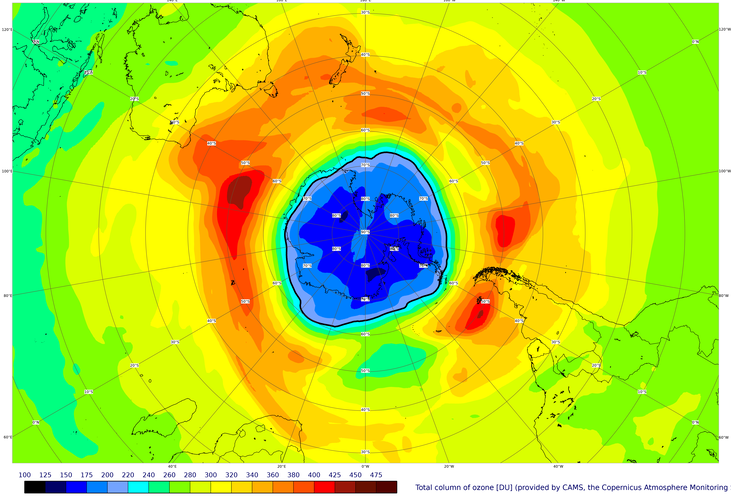
World governments agreed in the late 1980s to protect Earth’s ozone layer by phasing out ozone-depleting substances emitted by human activities, under the Montreal Protocol. The phase out of these substances has not only helped protect the ozone layer for future generations but has also protected human health and ecosystems by limiting the harmful ultraviolet radiation from reaching Earth. On 16 September, the International Day for the Preservation of the Ozone Layer, we take a closer look at this year’s ozone hole.
What’s going on with the ozone?
16.9.2021 13:10 ESA Observing the Earth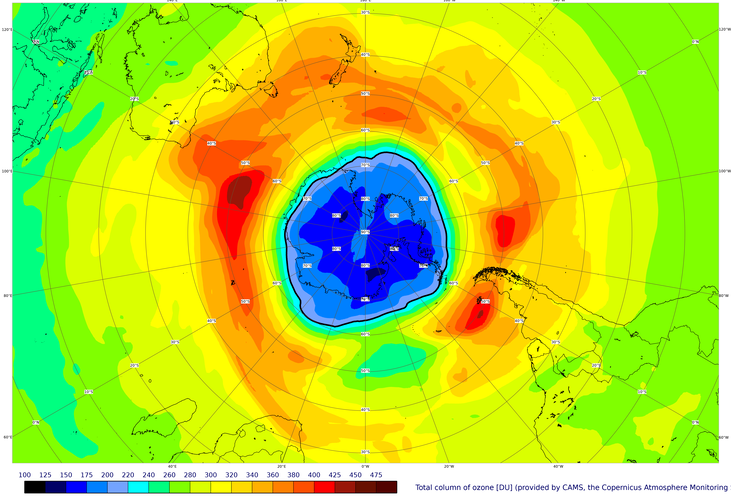
World governments agreed in the late 1980s to protect Earth’s ozone layer by phasing out ozone-depleting substances emitted by human activities, under the Montreal Protocol. The phase out of these substances has not only helped protect the ozone layer for future generations but has also protected human health and ecosystems by limiting the harmful ultraviolet radiation from reaching Earth. On 16 September, the International Day for the Preservation of the Ozone Layer, we take a closer look at this year’s ozone hole.
Vrchní referent / rada v oddělení dokumentace katastru nemovitostí Katastrálního pracoviště Jičín
16.9.2021 12:21 ČÚZK - předpisy a opatření Katastrální úřad pro Královéhradecký kraj - Katastrální pracoviště Jičínvypisuje výběrové řízení na místo
Vrchní referent / rada v oddělení dokumentace katastru nemovitostí Katastrálního pracoviště Jičín
Vrchní referent / rada v oddělení dokumentace katastru nemovitostí Katastrálního pracoviště Jičín
16.9.2021 12:21 ČÚZK /Urady/Katastralni-urady/Katastralni-urady/Katastralni-urad-pro-Kralovehradecky-kraj/Uredni-deska/Oznameni-a-jina-uredni-sdeleni/Volna-mista/Vrchni-referent-rada-v-oddeleni-dokumentace-kataVrchní referent / rada v oddělení dokumentace katastru nemovitostí Katastrálního pracoviště Jičín
16.9.2021 12:21 ČÚZK - volná místa Katastrální úřad pro Královéhradecký kraj - Katastrální pracoviště Jičín vypisuje výběrové řízení na místo Vrchní referent / rada v oddělení dokumentace katastru nemovitostí Katastrálního pracoviště JičínOdborný referent / vrchní referent v oddělení dokumentace Katastrálního pracoviště Jičín
16.9.2021 12:20 ČÚZK - volná místa Katastrální úřad pro Královéhradecký kraj - Katastrální pracoviště Jičín vypisuje výběrové řízení na místo Odborný referent / vrchní referent v oddělení dokumentace Katastrálního pracoviště JičínOdborný referent / vrchní referent v oddělení dokumentace Katastrálního pracoviště Jičín
16.9.2021 12:20 ČÚZK /Urady/Katastralni-urady/Katastralni-urady/Katastralni-urad-pro-Kralovehradecky-kraj/Uredni-deska/Oznameni-a-jina-uredni-sdeleni/Volna-mista/Odborny-referent-vrchni-referent-v-oddeleni-dokuOdborný referent / vrchní referent v oddělení dokumentace Katastrálního pracoviště Jičín
16.9.2021 12:20 ČÚZK - předpisy a opatření Katastrální úřad pro Královéhradecký kraj - Katastrální pracoviště Jičínvypisuje výběrové řízení na místo
Odborný referent / vrchní referent v oddělení dokumentace Katastrálního pracoviště Jičín
Historie navigace. Petr Scheirich vysvětluje, jak se Vikingové dokázali plavit bez kompasu
16.9.2021 10:09 GeoBusinessProč se Féničané, Arabové a Vikingové dokázali plavit bez kompasu? Proč se Kolumbus dokázal vrátit z Ameriky bez využití navigace podle hvězd? Co mají zeměpisná délka a šířka společného s délkovým a šířkovým rozměrem? Jak ovlivnilo hledání zeměpisné délky pokrok vědy a techniky v 18. století? Je využití astronavigace výhradní doménou mořeplavců? Na jakém principu funguje a jaké přístroje k ní potřebujeme? Jak se lodi […]
The post Historie navigace. Petr Scheirich vysvětluje, jak se Vikingové dokázali plavit bez kompasu appeared first on GeoBusiness.
Kartografická soutěž Mapa roku 2020
16.9.2021 10:03 ČÚZK - Geoportál Kartografická soutěž Mapa roku 2020Na kartografické konferenci v Ostravě byly v rámci 23. ročníku soutěže Mapa roku 2020 udělovány ceny za nejlepší kartografická díla vydaná na území České republiky.
Hodnotící komise České kartografické společnosti udělila Zvláštní ocenění Zeměměřickému úřadu za vývoj uživatelsky hodnotných webových mapových aplikací.
Kartografická soutěž Mapa roku 2020
16.9.2021 10:03 ČÚZK - Geoportál Kartografická soutěž Mapa roku 2020Na kartografické konferenci v Ostravě byly v rámci 23. ročníku soutěže Mapa roku 2020 udělovány ceny za nejlepší kartografická díla vydaná na území České republiky.
Hodnotící komise České kartografické společnosti udělila Zvláštní ocenění Zeměměřickému úřadu za vývoj uživatelsky hodnotných webových mapových aplikací.
Kartografická soutež Mapa roku 2020
16.9.2021 10:03 ČÚZK - Geoportál Kartografická soutež Mapa roku 2020Na kartografické konferenci v Ostrave byly v rámci 23. rocníku souteže Mapa roku 2020 udelovány ceny za nejlepší kartografická díla vydaná na území Ceské republiky.
Hodnotící komise Ceské kartografické spolecnosti udelila Zvláštní ocenení Zememerickému úradu za vývoj uživatelsky hodnotných webových mapových aplikací.
Kartografická soutěž Mapa roku 2020
16.9.2021 10:03 ČÚZK - Geoportál Kartografická soutěž Mapa roku 2020Na kartografické konferenci v Ostravě byly v rámci 23. ročníku soutěže Mapa roku 2020 udělovány ceny za nejlepší kartografická díla vydaná na území České republiky.
Hodnotící komise České kartografické společnosti udělila Zvláštní ocenění Zeměměřickému úřadu za vývoj uživatelsky hodnotných webových mapových aplikací.
Kartografická soutež Mapa roku 2020
16.9.2021 10:03 ČÚZK - Geoportál Kartografická soutež Mapa roku 2020Na kartografické konferenci v Ostrave byly v rámci 23. rocníku souteže Mapa roku 2020 udelovány ceny za nejlepší kartografická díla vydaná na území Ceské republiky.
Hodnotící komise Ceské kartografické spolecnosti udelila Zvláštní ocenení Zememerickému úradu za vývoj uživatelsky hodnotných webových mapových aplikací.
Kartografická soutěž Mapa roku 2020
16.9.2021 10:03 ČÚZK - Geoportál Kartografická soutěž Mapa roku 2020Na kartografické konferenci v Ostravě byly v rámci 23. ročníku soutěže Mapa roku 2020 udělovány ceny za nejlepší kartografická díla vydaná na území České republiky.
Hodnotící komise České kartografické společnosti udělila Zvláštní ocenění Zeměměřickému úřadu za vývoj uživatelsky hodnotných webových mapových aplikací.
Kartografická soutěž Mapa roku 2020
16.9.2021 10:03 ČÚZK - Geoportál Kartografická soutěž Mapa roku 2020Na kartografické konferenci v Ostravě byly v rámci 23. ročníku soutěže Mapa roku 2020 udělovány ceny za nejlepší kartografická díla vydaná na území České republiky.
Hodnotící komise České kartografické společnosti udělila Zvláštní ocenění Zeměměřickému úřadu za vývoj uživatelsky hodnotných webových mapových aplikací.
Kartografická soutež Mapa roku 2020
16.9.2021 10:03 ČÚZK - Geoportál Kartografická soutež Mapa roku 2020Na kartografické konferenci v Ostrave byly v rámci 23. rocníku souteže Mapa roku 2020 udelovány ceny za nejlepší kartografická díla vydaná na území Ceské republiky.
Hodnotící komise Ceské kartografické spolecnosti udelila Zvláštní ocenení Zememerickému úradu za vývoj uživatelsky hodnotných webových mapových aplikací.
Zlatá éra rozvoje technických map a digitalizace inženýrských sítí
16.9.2021 9:47 ZeměměřičFirma Hrdlička oslavila 16. září 2021 přesně třicet let od svého založení. Jak byla devadesátá léta ve znamení velkého růstu, tak první dekáda 21. století je charakteristická stabilizací vytvořených trhů. Firma Hrdlička nadále obratově rostla také díky rozsáhlým projektům, ve kterých na zakázku digitalizovala technické mapy s průběhy inženýrských sítí nejen pro obce a města, ale také pro vlastníky […]
The post Zlatá éra rozvoje technických map a digitalizace inženýrských sítí appeared first on Zeměměřič.
Kartografická soutež Mapa roku 2020
16.9.2021 9:03 ČÚZK - Geoportál Kartografická soutež Mapa roku 2020Na kartografické konferenci v Ostrave byly v rámci 23. rocníku souteže Mapa roku 2020 udelovány ceny za nejlepší kartografická díla vydaná na území Ceské republiky.
Hodnotící komise Ceské kartografické spolecnosti udelila Zvláštní ocenení Zememerickému úradu za vývoj uživatelsky hodnotných webových mapových aplikací.
Kartografická soutež Mapa roku 2020
16.9.2021 9:03 ČÚZK - Geoportál Kartografická soutež Mapa roku 2020Na kartografické konferenci v Ostrave byly v rámci 23. rocníku souteže Mapa roku 2020 udelovány ceny za nejlepší kartografická díla vydaná na území Ceské republiky.
Hodnotící komise Ceské kartografické spolecnosti udelila Zvláštní ocenení Zememerickému úradu za vývoj uživatelsky hodnotných webových mapových aplikací.
Kartografická soutěž Mapa roku 2020
16.9.2021 9:03 ČÚZK - Geoportál Kartografická soutěž Mapa roku 2020Na kartografické konferenci v Ostravě byly v rámci 23. ročníku soutěže Mapa roku 2020 udělovány ceny za nejlepší kartografická díla vydaná na území České republiky.
Hodnotící komise České kartografické společnosti udělila Zvláštní ocenění Zeměměřickému úřadu za vývoj uživatelsky hodnotných webových mapových aplikací.
Kartografická soutěž Mapa roku 2020
16.9.2021 9:03 ČÚZK - Geoportál Kartografická soutěž Mapa roku 2020Na kartografické konferenci v Ostravě byly v rámci 23. ročníku soutěže Mapa roku 2020 udělovány ceny za nejlepší kartografická díla vydaná na území České republiky.
Hodnotící komise České kartografické společnosti udělila Zvláštní ocenění Zeměměřickému úřadu za vývoj uživatelsky hodnotných webových mapových aplikací.
Kartografická soutěž Mapa roku 2020
16.9.2021 9:03 ČÚZK - Geoportál Kartografická soutěž Mapa roku 2020Na kartografické konferenci v Ostravě byly v rámci 23. ročníku soutěže Mapa roku 2020 udělovány ceny za nejlepší kartografická díla vydaná na území České republiky.
Hodnotící komise České kartografické společnosti udělila Zvláštní ocenění Zeměměřickému úřadu za vývoj uživatelsky hodnotných webových mapových aplikací.
Kartografická soutěž Mapa roku 2020
16.9.2021 9:03 ČÚZK - Geoportál Kartografická soutěž Mapa roku 2020Na kartografické konferenci v Ostravě byly v rámci 23. ročníku soutěže Mapa roku 2020 udělovány ceny za nejlepší kartografická díla vydaná na území České republiky.
Hodnotící komise České kartografické společnosti udělila Zvláštní ocenění Zeměměřickému úřadu za vývoj uživatelsky hodnotných webových mapových aplikací.
Kartografická soutěž Mapa roku 2020
16.9.2021 9:03 ČÚZK - Geoportál Kartografická soutěž Mapa roku 2020Na kartografické konferenci v Ostravě byly v rámci 23. ročníku soutěže Mapa roku 2020 udělovány ceny za nejlepší kartografická díla vydaná na území České republiky.
Hodnotící komise České kartografické společnosti udělila Zvláštní ocenění Zeměměřickému úřadu za vývoj uživatelsky hodnotných webových mapových aplikací.
Kartografická soutež Mapa roku 2020
16.9.2021 9:03 ČÚZK - Geoportál Kartografická soutež Mapa roku 2020Na kartografické konferenci v Ostrave byly v rámci 23. rocníku souteže Mapa roku 2020 udelovány ceny za nejlepší kartografická díla vydaná na území Ceské republiky.
Hodnotící komise Ceské kartografické spolecnosti udelila Zvláštní ocenení Zememerickému úradu za vývoj uživatelsky hodnotných webových mapových aplikací.
Kartografická soutež Mapa roku 2020
16.9.2021 9:03 ČÚZK - Geoportál Kartografická soutež Mapa roku 2020Na kartografické konferenci v Ostrave byly v rámci 23. rocníku souteže Mapa roku 2020 udelovány ceny za nejlepší kartografická díla vydaná na území Ceské republiky.
Hodnotící komise Ceské kartografické spolecnosti udelila Zvláštní ocenení Zememerickému úradu za vývoj uživatelsky hodnotných webových mapových aplikací.
Kartografická soutěž Mapa roku 2020
16.9.2021 9:03 ČÚZK - Geoportál Kartografická soutěž Mapa roku 2020Na kartografické konferenci v Ostravě byly v rámci 23. ročníku soutěže Mapa roku 2020 udělovány ceny za nejlepší kartografická díla vydaná na území České republiky.
Hodnotící komise České kartografické společnosti udělila Zvláštní ocenění Zeměměřickému úřadu za vývoj uživatelsky hodnotných webových mapových aplikací.
Kartografická soutěž Mapa roku 2020
16.9.2021 9:03 ČÚZK - Geoportál Kartografická soutěž Mapa roku 2020Na kartografické konferenci v Ostravě byly v rámci 23. ročníku soutěže Mapa roku 2020 udělovány ceny za nejlepší kartografická díla vydaná na území České republiky.
Hodnotící komise České kartografické společnosti udělila Zvláštní ocenění Zeměměřickému úřadu za vývoj uživatelsky hodnotných webových mapových aplikací.
Kartografická soutěž Mapa roku 2020
16.9.2021 9:03 ČÚZK - Geoportál Kartografická soutěž Mapa roku 2020Na kartografické konferenci v Ostravě byly v rámci 23. ročníku soutěže Mapa roku 2020 udělovány ceny za nejlepší kartografická díla vydaná na území České republiky.
Hodnotící komise České kartografické společnosti udělila Zvláštní ocenění Zeměměřickému úřadu za vývoj uživatelsky hodnotných webových mapových aplikací.
Kartografická soutež Mapa roku 2020
16.9.2021 9:03 ČÚZK - Geoportál Kartografická soutež Mapa roku 2020Na kartografické konferenci v Ostrave byly v rámci 23. rocníku souteže Mapa roku 2020 udelovány ceny za nejlepší kartografická díla vydaná na území Ceské republiky.
Hodnotící komise Ceské kartografické spolecnosti udelila Zvláštní ocenení Zememerickému úradu za vývoj uživatelsky hodnotných webových mapových aplikací.
Kartografická soutěž Mapa roku 2020
16.9.2021 9:03 ČÚZK - Geoportál Kartografická soutěž Mapa roku 2020Na kartografické konferenci v Ostravě byly v rámci 23. ročníku soutěže Mapa roku 2020 udělovány ceny za nejlepší kartografická díla vydaná na území České republiky.
Hodnotící komise České kartografické společnosti udělila Zvláštní ocenění Zeměměřickému úřadu za vývoj uživatelsky hodnotných webových mapových aplikací.
Kartografická soutež Mapa roku 2020
16.9.2021 9:03 ČÚZK - Geoportál Kartografická soutež Mapa roku 2020Na kartografické konferenci v Ostrave byly v rámci 23. rocníku souteže Mapa roku 2020 udelovány ceny za nejlepší kartografická díla vydaná na území Ceské republiky.
Hodnotící komise Ceské kartografické spolecnosti udelila Zvláštní ocenení Zememerickému úradu za vývoj uživatelsky hodnotných webových mapových aplikací.
Kartografická soutež Mapa roku 2020
16.9.2021 9:03 ČÚZK - Geoportál Kartografická soutež Mapa roku 2020Na kartografické konferenci v Ostrave byly v rámci 23. rocníku souteže Mapa roku 2020 udelovány ceny za nejlepší kartografická díla vydaná na území Ceské republiky.
Hodnotící komise Ceské kartografické spolecnosti udelila Zvláštní ocenení Zememerickému úradu za vývoj uživatelsky hodnotných webových mapových aplikací.
Kartografická soutěž Mapa roku 2020
16.9.2021 9:03 ČÚZK - Geoportál Kartografická soutěž Mapa roku 2020Na kartografické konferenci v Ostravě byly v rámci 23. ročníku soutěže Mapa roku 2020 udělovány ceny za nejlepší kartografická díla vydaná na území České republiky.
Hodnotící komise České kartografické společnosti udělila Zvláštní ocenění Zeměměřickému úřadu za vývoj uživatelsky hodnotných webových mapových aplikací.
Kartografická soutež Mapa roku 2020
16.9.2021 9:03 ČÚZK - Geoportál Kartografická soutež Mapa roku 2020Na kartografické konferenci v Ostrave byly v rámci 23. rocníku souteže Mapa roku 2020 udelovány ceny za nejlepší kartografická díla vydaná na území Ceské republiky.
Hodnotící komise Ceské kartografické spolecnosti udelila Zvláštní ocenení Zememerickému úradu za vývoj uživatelsky hodnotných webových mapových aplikací.
Kartografická soutěž Mapa roku 2020
16.9.2021 9:03 ČÚZK - Geoportál Kartografická soutěž Mapa roku 2020Na kartografické konferenci v Ostravě byly v rámci 23. ročníku soutěže Mapa roku 2020 udělovány ceny za nejlepší kartografická díla vydaná na území České republiky.
Hodnotící komise České kartografické společnosti udělila Zvláštní ocenění Zeměměřickému úřadu za vývoj uživatelsky hodnotných webových mapových aplikací.
Kartografická soutež Mapa roku 2020
16.9.2021 9:03 ČÚZK - Geoportál Kartografická soutež Mapa roku 2020Na kartografické konferenci v Ostrave byly v rámci 23. rocníku souteže Mapa roku 2020 udelovány ceny za nejlepší kartografická díla vydaná na území Ceské republiky.
Hodnotící komise Ceské kartografické spolecnosti udelila Zvláštní ocenení Zememerickému úradu za vývoj uživatelsky hodnotných webových mapových aplikací.
Kartografická soutěž Mapa roku 2020
16.9.2021 9:03 ČÚZK - Geoportál Kartografická soutěž Mapa roku 2020Na kartografické konferenci v Ostravě byly v rámci 23. ročníku soutěže Mapa roku 2020 udělovány ceny za nejlepší kartografická díla vydaná na území České republiky.
Hodnotící komise České kartografické společnosti udělila Zvláštní ocenění Zeměměřickému úřadu za vývoj uživatelsky hodnotných webových mapových aplikací.
Kartografická soutež Mapa roku 2020
16.9.2021 9:03 ČÚZK - Geoportál Kartografická soutež Mapa roku 2020Na kartografické konferenci v Ostrave byly v rámci 23. rocníku souteže Mapa roku 2020 udelovány ceny za nejlepší kartografická díla vydaná na území Ceské republiky.
Hodnotící komise Ceské kartografické spolecnosti udelila Zvláštní ocenení Zememerickému úradu za vývoj uživatelsky hodnotných webových mapových aplikací.
Kartografická soutež Mapa roku 2020
16.9.2021 9:03 ČÚZK - Geoportál Kartografická soutež Mapa roku 2020Na kartografické konferenci v Ostrave byly v rámci 23. rocníku souteže Mapa roku 2020 udelovány ceny za nejlepší kartografická díla vydaná na území Ceské republiky.
Hodnotící komise Ceské kartografické spolecnosti udelila Zvláštní ocenení Zememerickému úradu za vývoj uživatelsky hodnotných webových mapových aplikací.
Kartografická soutež Mapa roku 2020
16.9.2021 9:03 ČÚZK - Geoportál Kartografická soutež Mapa roku 2020Na kartografické konferenci v Ostrave byly v rámci 23. rocníku souteže Mapa roku 2020 udelovány ceny za nejlepší kartografická díla vydaná na území Ceské republiky.
Hodnotící komise Ceské kartografické spolecnosti udelila Zvláštní ocenení Zememerickému úradu za vývoj uživatelsky hodnotných webových mapových aplikací.
Kartografická soutež Mapa roku 2020
16.9.2021 9:03 ČÚZK - Geoportál Kartografická soutež Mapa roku 2020Na kartografické konferenci v Ostrave byly v rámci 23. rocníku souteže Mapa roku 2020 udelovány ceny za nejlepší kartografická díla vydaná na území Ceské republiky.
Hodnotící komise Ceské kartografické spolecnosti udelila Zvláštní ocenení Zememerickému úradu za vývoj uživatelsky hodnotných webových mapových aplikací.
Kartografická soutež Mapa roku 2020
16.9.2021 9:03 ČÚZK - Geoportál Kartografická soutež Mapa roku 2020Na kartografické konferenci v Ostrave byly v rámci 23. rocníku souteže Mapa roku 2020 udelovány ceny za nejlepší kartografická díla vydaná na území Ceské republiky.
Hodnotící komise Ceské kartografické spolecnosti udelila Zvláštní ocenení Zememerickému úradu za vývoj uživatelsky hodnotných webových mapových aplikací.
Kartografická soutěž Mapa roku 2020
16.9.2021 9:03 ČÚZK - Geoportál Kartografická soutěž Mapa roku 2020Na kartografické konferenci v Ostravě byly v rámci 23. ročníku soutěže Mapa roku 2020 udělovány ceny za nejlepší kartografická díla vydaná na území České republiky.
Hodnotící komise České kartografické společnosti udělila Zvláštní ocenění Zeměměřickému úřadu za vývoj uživatelsky hodnotných webových mapových aplikací.
20210916-Mapa roku 2020
16.9.2021 9:02 ČÚZK - předpisy a opatření Zeměměřický úřadzveřejnil novou aktualitu: Na kartografické konferenci v Ostravě byly v rámci 23. ročníku soutěže Mapa roku 2020 udělovány ceny za nejlepší kartografická díla vydaná na území České republiky. Hodnotící komise České kartografické společnosti udělila Zvláštní ocenění Zeměměřickému úřadu za vývoj uživatelsky hodnotných webových mapových aplikací.
20210916-Mapa roku 2020
16.9.2021 9:02 ČÚZK /Urady/Zememericky-urad/O-uradu/Aktuality/20210916-Nove-cislo-GaKO20210916-Mapa roku 2020
16.9.2021 9:02 Zeměměřický úřad Zeměměřický úřadzveřejnil novou aktualitu: Na kartografické konferenci v Ostravě byly v rámci 23. ročníku soutěže Mapa roku 2020 udělovány ceny za nejlepší kartografická díla vydaná na území České republiky. Hodnotící komise České kartografické společnosti udělila Zvláštní ocenění Zeměměřickému úřadu za vývoj uživatelsky hodnotných webových mapových aplikací.
exactEarth Announces Q3 Fiscal 2021 Financial Results and Agreement to be Acquired by Spire Global
16.9.2021 9:00 GISCafe.com Webcasts-Webinars - exactEarth has entered into an agreement to be acquired by Spire Global for $204.2 million in cash and equity- Consideration of $3.90 per …
Continental Mapping Consultants Awarded GSA FEDSIM ASTRO Prime Contract
16.9.2021 2:17 GISCafe.com Webcasts-Webinars Contract Vehicle Allows Department of Defense and Other Agencies to Invest in Data Operations and BeyondSUN PRAIRIE, Wis., Sept. 15, 2021 — …
Commercial UAV Expo 2021 Reconvenes In-Person, Exceeds Expectations
16.9.2021 2:16 GISCafe.com Webcasts-Webinars The full power of the drone industry was on display as nearly 2,000 commercial drone professionals gathered in-personLAS VEGAS, Sept. 15, 2021 …
Virtuální seminář Kartografická výročí 2020/2021 – 300 let Müllerovy mapy Čech [Knihovna geografie, byTopic]
16.9.2021 0:00 Katedra aplikované geoinformatiky a kartografie Přf UK V roce 2020 připravovali historičtí kartografové odborný seminář k připomenutí výročí 300 let od vzniku velké mapy Čech J. K. Müllera. S ohledem na pandemickou situaci byl však seminář přeložen na letošní rok a uskutečňuje se virtuálně (odkazy níže).
Nové číslo GaKO
15.9.2021 20:40
ÚGKK SR
Nové číslo časopisu Geodetického a Kartografického Obzoru 09/2021
DTM, DMVS, geoprostorová data a služby na konferenci ISSS 2021
15.9.2021 20:07 GeoBusinessDo Hradce Králové se po roční kovidové výluce vrací konference ISSS – Internet ve státní správě a samosprávě. Součástí dvoudenní konference ISSS 2021 ve dnech 20. a 21. září, která oproti předchozím letům nebude zahrnovat expozici s firmami, bude také geoinformační tematika. Veškeré níže uvedené referáty jsou v programu naplánovány na pondělí 21. září. DTM a DMVS 16.40–17.25 – DMVS Projekt DMVS v resortu ČÚZK, […]
The post DTM, DMVS, geoprostorová data a služby na konferenci ISSS 2021 appeared first on GeoBusiness.
Získejte až 800 tisíc korun v programu Prototypuj a ověřuj. Brno podporuje vznik startupů
15.9.2021 19:28 GeoBusinessVíce než dva miliony korun rozdělí inovační agentura JIC společně s městem Brnem mezi nadějné startupisty v další výzvě programu Prototypuj a ověřuj. Do 22. října mohou své nápady přihlašovat a požádat o grant ve výši až 800 tisíc korun. Granty jsou určeny pro firmy se sídlem nebo provozovnou v Jihomoravském kraji s maximálním obratem 10 milionů korun. Žádat mohou i fyzické osoby, v případě […]
The post Získejte až 800 tisíc korun v programu Prototypuj a ověřuj. Brno podporuje vznik startupů appeared first on GeoBusiness.
California continues to burn
15.9.2021 18:00 ESA Observing the Earth
While wildfires are a natural part of California’s landscape, a severe drought, coupled with extreme temperatures, have sustained several major fires for much of August. As of 14 September, more than 7000 wildfires have been recorded, burning over 900 000 hectares across the state.
California continues to burn
15.9.2021 18:00 ESA Observing the Earth
While wildfires are a natural part of California’s landscape, a severe drought, coupled with extreme temperatures, have sustained several major fires for much of August. As of 14 September, more than 7000 wildfires have been recorded, burning over 900 000 hectares across the state.
California continues to burn
15.9.2021 18:00 ESA Observing the Earth
While wildfires are a natural part of California’s landscape, a severe drought, coupled with extreme temperatures, have sustained several major fires for much of August. As of 14 September, more than 7000 wildfires have been recorded, burning over 900 000 hectares across the state.
Velodyne Lidar Calls for Action to Improve Pedestrian Safety
15.9.2021 17:48 GISCafe.com Webcasts-Webinars New Velodyne White Paper Published by SAE International Shows How Advanced Driver Assistance Systems (ADAS) Can be Improved to Reduce Nighttime …Woolpert Acquires AAM, Global Geospatial Leader
15.9.2021 17:48 GISCafe.com Webcasts-Webinars Together, the companies will increase their mapping and cloud-based geospatial data capabilities, combining technologies and best practices to …Aquiline Drones Acquires ElluminAI Labs to Create Deep Learning Drones and Cloud Ops
15.9.2021 17:48 GISCafe.com Webcasts-Webinars All Roads Lead to Artificial Intelligence (AI) with New Drone Industry DealHARTFORD, Conn., Sept. 15, 2021 — (PRNewswire) —
HARTFORD, …
Sokkia Tour 2021 bude počátkem října v Praze, Ostravě a Brně
15.9.2021 16:22 ZeměměřičSpolečnost 3GON Positioning pořádá podzimní setkání s přístroji značky Sokkia. Sokkia Tour 2021 bude mít zastávky v Praze, Ostravě a Brně. Vstup je zdarma, stačí nahlásit, že přijdete na e-mailu obchod@3gon.eu
The post Sokkia Tour 2021 bude počátkem října v Praze, Ostravě a Brně appeared first on Zeměměřič.



